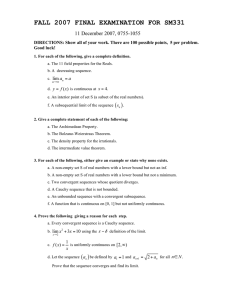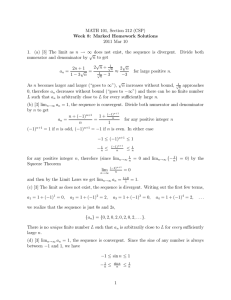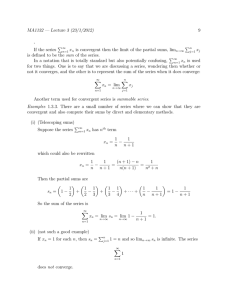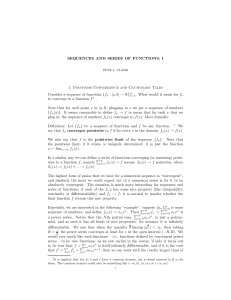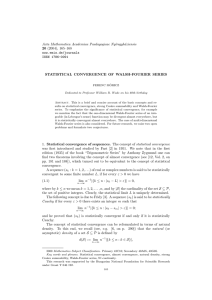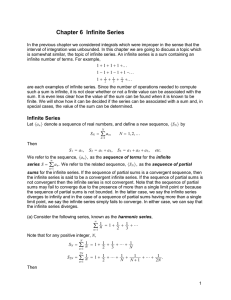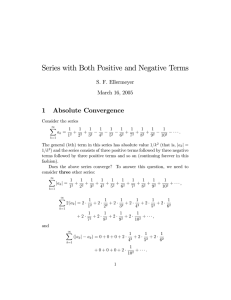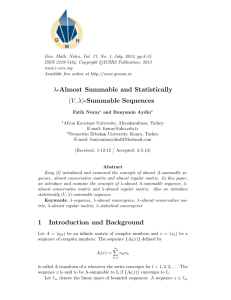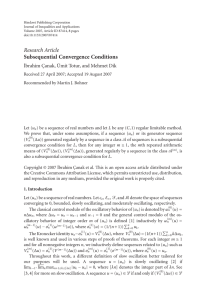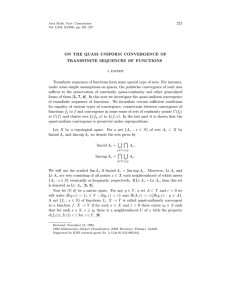MATH 501 Fall 2006 Final Exam Explain your answers carefully. 10 points each
advertisement
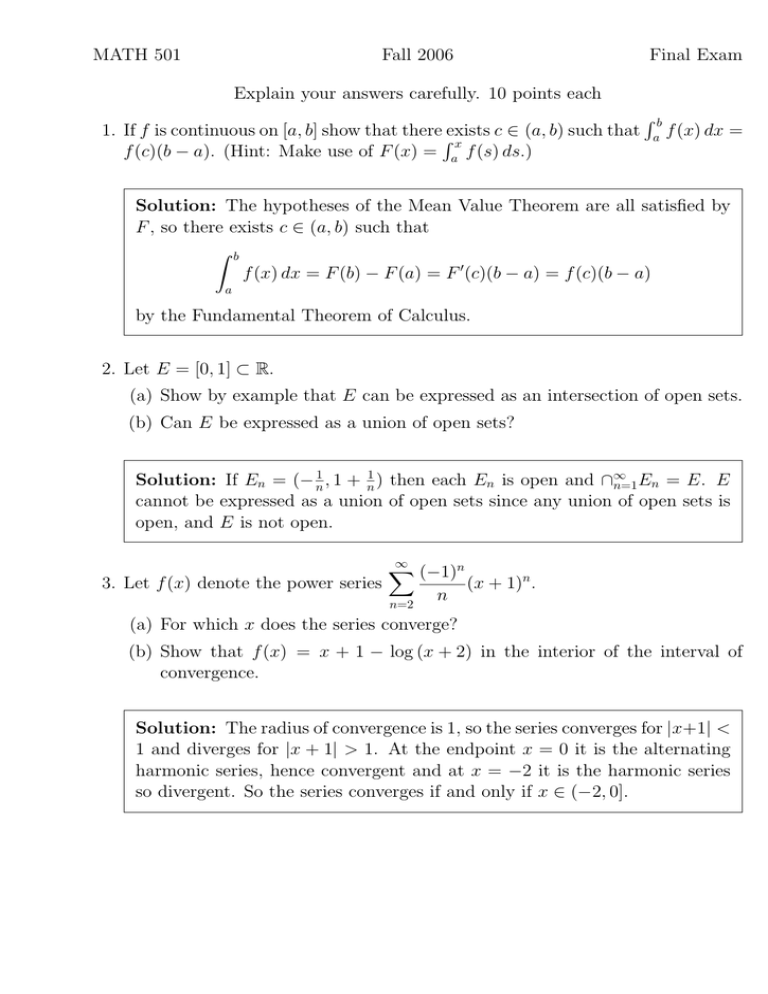
MATH 501 Fall 2006 Final Exam Explain your answers carefully. 10 points each 1. If f is continuous on [a, b] show that thereRexists c ∈ (a, b) such that x f (c)(b − a). (Hint: Make use of F (x) = a f (s) ds.) Rb a f (x) dx = Solution: The hypotheses of the Mean Value Theorem are all satisfied by F , so there exists c ∈ (a, b) such that Z b f (x) dx = F (b) − F (a) = F 0 (c)(b − a) = f (c)(b − a) a by the Fundamental Theorem of Calculus. 2. Let E = [0, 1] ⊂ R. (a) Show by example that E can be expressed as an intersection of open sets. (b) Can E be expressed as a union of open sets? Solution: If En = (− n1 , 1 + n1 ) then each En is open and ∩∞ n=1 En = E. E cannot be expressed as a union of open sets since any union of open sets is open, and E is not open. 3. Let f (x) denote the power series ∞ X (−1)n n=2 n (x + 1)n . (a) For which x does the series converge? (b) Show that f (x) = x + 1 − log (x + 2) in the interior of the interval of convergence. Solution: The radius of convergence is 1, so the series converges for |x+1| < 1 and diverges for |x + 1| > 1. At the endpoint x = 0 it is the alternating harmonic series, hence convergent and at x = −2 it is the harmonic series so divergent. So the series converges if and only if x ∈ (−2, 0]. MATH 501 Fall 2006 Final Exam The series can be differentiated term by term in the interior of this interval, so that 0 f (x) = ∞ X n (−1) (x + 1) n−1 n=2 = (x + 1) ∞ X (−(x + 1))n n=0 The last sum is a geometric series with ratio −(x + 1) so is equal to 1 1 = 1 − (−(x + 1)) x + 2 Thus we get x+1 x+2 Integrate this using f (−1) = 0 to get the stated formula for f . f 0 (x) = x − log x e (a) Show that f (x) > 0 for x > e. 4. Let f (x) = (b) Use the result of (a) to decide which is larger, eπ or π e ? Solution: We have f 0 (x) = 1e − x1 > 0 if x > e. Thus f (x) > f (e) = 0 if x > e. In particular f (π) > 0 so that πe > log π. Solving and rearranging this inequality gives eπ > π e . 5. Find the value of the limit n X 1 n→∞ n+i i=1 Pn 1 (Suggestion: Find a, b, f so that the sum i=1 n+i is a Riemann sum for Rb a f (x) dx.) lim spaced partition Solution: If we let f (x) = x1 on [1, 2] and choose equally P n points xi = 1 + ni , i = 0, . . . n then the above sum is i=1 f (xi )∆xi which we can regard as either a Riemann sum or the lower sum for this partition. Rb As n → ∞ it converges to a f (x) dx = log 2. Page 2 MATH 501 Fall 2006 Final Exam P P∞ p 6. If ∞ a is absolutely convergent, show that n n=1 n=1 |an | is convergent for any p > 1. P Solution: If ∞ n=1 an is absolutely convergent then limn→∞ |an | = 0 and in particular this sequence is bounded, i.e. there exists M ∈ R such that |an | ≤ M for all n. It follows that |an |p ≤ M p−1 |an | so that ∞ X p |an | ≤ M n=1 p−1 ∞ X |an | n=1 and so is convergent. 7. Let f, g : X → R and h(x) = (f ∨ g)(x) = max (f (x), g(x)) f (x) + g(x) + |f (x) − g(x)| . 2 (b) If f, g are continuous, show that h is also continuous. (a) Show that h(x) = Solution: To show the identity in part a) just consider the two cases f (x) ≥ g(x) and f (x) < g(x), e.g. in the first case h(x) = f (x) = f (x) + g(x) + (f (x) − g(x)) f (x) + g(x) + |f (x) − g(x)| = 2 2 If f, g are both continuous it follows that f + g, and then |f + g| are also continuous, and the continuity of h follows. 8. If p(x) is a cubic polynomial with real coefficients, show that p has at least one real root. Solution: If p(x) = Ax3 + Bx2 + Cx + D with A, B, C, D real and A 6= 0 then you can show that lim p(x) = +∞ x→+∞ Page 3 lim = −∞ x→−∞ MATH 501 Fall 2006 Final Exam if A > 0 and lim p(x) = −∞ x→+∞ lim = +∞ x→−∞ if A < 0. Either way there must exist points x1 , x2 such that p(x1 ) < 0 and p(x2 ) > 0. Since p is continuous on any interval, a root must exist by the Intermediate Value Theorem. xn 9. Let fn (x) = for 0 ≤ x ≤ 2. 1 + xn (a) Find the pointwise limit f (x) = limn→∞ fn (x) on [0, 2]. (b) Does fn → f uniformly on [0, 2]? Solution: The pointwise limit is 0 0 ≤ x < 1 f (x) = 12 x = 1 1 1<x≤2 The convergence cannot be uniform because if it were f would have to be continuous. 10. From the theory of Fourier series it can be shown that 2 x−x = ∞ X n=1 8 sin ((2n − 1)πx) ((2n − 1)π)3 0≤x≤1 Using this identity find the value of the infinite series ∞ X n=1 1 (2n − 1)4 (Suggestion: integrate both sides of the identity from 0 to 1. Justify all steps.) Page 4 MATH 501 Fall 2006 Final Exam Solution: The series on the right is uniformly convergent on [0, 1] by the 8 Weierstrass M test, using Mn = . It is therefore correct to ((2n − 1)π)3 integrate term by term to get Z 1 Z 1 ∞ X 1 8 2 = (x − x ) dx = sin ((2n − 1)πx) 3 6 ((2n − 1)π) 0 0 n=1 The integral on the right is 2 so we get (2n − 1)π ∞ 1 X 16 = 6 n=1 ((2n − 1)π)4 π4 from which it follows that sum of the requested series is . 96 Page 5


